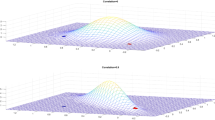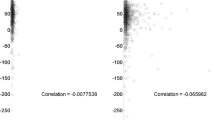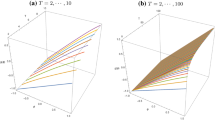Abstract
We use the method of indirect inference, using the bootstrap, to test the Smets and Wouters model of the EU against a VAR auxiliary equation describing their data. We find that their model generates excessive variance compared with the data. But their model fits the dynamic facts quite well if the errors have the properties assumed by SW but scaled down. We compare a New Classical version of the model which also performs reasonably if error properties are chosen using New Classical priors (notably excluding shocks to preferences). Both versions have (different) difficulties fitting the data if the actual error properties are used. A model combining rigid and flexible-wage/price sectors, with a weight of around 5% on the rigid sector, does best in fitting the data.







Similar content being viewed by others
Notes
Needless to say, none of the above discussion on estimating the structural residuals has anything to do with how the model is solved for given shocks once the residuals and their time-series processes have been estimated and built into the model. The solution method here follows the standard dynare procedure.
Let the model be given by Ay t = ME t y t + 1 + Ny t − 1 + u t , where u t = Φu t − 1 + ε t . This can be transformed into \( y_{t}=A^{-1}MB^{-1}y_{t}+A^{-1}NLy_{t}+A^{-1}u_{t}\); where L is the lag operator and B − 1 is the forward operator leading the variable while keeping the date of expectations constant (here at t). Assume that the model satisfies the saddlepath Blanchard-Kahn conditions (with f forward and l backward roots), then we can rewrite it as \(\prod\limits_{i=1}^{f}(1-\gamma _{i}B^{-1})\prod\limits_{j=1}^{l}(1-\lambda _{j}L)y_{t}=K(L;M,N,A)u_{t}.\) Here we note that K is a function of all the parameters of the model, as well as involving lags of the errors produced by the backward roots and current values of the errors produced by the forward roots. We can solve for y t in terms of the current shocks and its own lagged values by projecting the forward roots onto the errors and then projecting all the backward roots, as well as error autoregressive roots, onto y t . It is clear that the impact effect, just like the transmission effect, comes from the complete parameter set.
References
Annexes (2009) Supporting annexes to this paper. Available at www.cf.ac.uk/carbs/faculty/minfordp/SWEUAnnex.pdf
Canova F (1994) Statistical inference in calibrated models. J Appl Econ 9:S123–S144
Canova F (2005) Methods for applied macroeconomic research. Princeton University Press, Princeton
Canzoneri MB, Cumby RE, Diba BT (2007) Euler equations and money market interest rates: a challenge for monetary policy models. J Monet Econ 54:1863–1881
Christiano L, Eichenbaum M, Evans C (2005) Nominal rigidities and the dynamic effects of a shock to monetary policy. J Polit Econ 113:1–45
Evans GW, Honkapohja S (2005) An interview with Thomas J. Sargent. Macroecon Dyn 9:561–583
Gourieroux C, Monfort A (1995) Simulation based econometric methods. CORE Lectures Series, Louvain-la-Neuve
Gourieroux C, Monfort A, Renault E (1993) Indirect inference. J Appl Econ 8:85–118
Gregory A, Smith G (1991) Calibration as testing: inference in simulated macro models. J Bus Econ Stat 9:293–303
Gregory A, Smith G (1993) Calibration in macroeconomics. In: Maddala G (ed) Handbook of statistics, vol 11. Elsevier, St. Louis, pp 703–719
Juillard M (2001) Dynare: a program for the simulation of rational expectations models. Computing in economics and finance 213. Society for Computational Economics
Lucas R (1972) Expectations and the neutrality of money. J Econ Theory 4:103–124
Mankiw G, Reis R (2002) Sticky information versus sticky prices: a proposal to replace the new Keynesian Phillips curve. Q J Econ 117:1295–1328
Sims C (2003) Implications of rational inattention. J Monet Econ 50:665–690
Smets F, Wouters R (2003) An estimated stochastic dsge model of the euro area. J Eur Econ Assoc 1:1123–1175
Smith AA (1993) Estimating nonlinear time-series models using simulated vector autoregressions. J Appl Econ 8:S63–S84
Acknowledgements
We are grateful for helpful comments on earlier drafts to Matthew Canzoneri, Harris Dellas, Casper de Vries, Alessandro Flamini, Max Gillman, John Hunter, Vo Phuong Mai Le, Adrian Pagan, and Christoph Thoenissen. We also thank Konstantinos Theodoridis for his substantial input in the early stages of this work. None of those mentioned bears any responsibility for errors in the present version of the paper. Our work was supported by the UK Economic and Social Research Council under grant no RES-165-25-0020.
Author information
Authors and Affiliations
Corresponding author
Appendix: The Smets-Wouters model
Appendix: The Smets-Wouters model
1.1 Households
The household utility function is
where c it ,n it , and \(\frac{M_{it}}{P_{it}}\) denote the consumption, work and real money balances of the i th household, the \(\varepsilon _{t}^{i}\), (i = B,n,m) are preference shocks, and P t is the general price level. The term hc t − 1 is to capture consumption habits, where c t is aggregate consumption. The real household budget constraint is
where bonds B it are one-period securities with a price of \(p_{t}^{B}\). Total household income is
where w it is the real wage rate, k it is the capital stock, \( r_{t}^{k}\) is the rate of return to capital, the term \( r_{t}^{k}z_{it}k_{i,t-1}-\Psi (z_{it})k_{i,t-1}\) represents income from capital after depreciation, z it is capacity utilisation and d it is dividend income.
The resulting Euler equation is
where R t is the gross nominal rate of return on bonds \(\big(R_{t}=\frac{1}{ p_{t}^{B}}\big)\) and λ t is the marginal utility of consumption:
The demand for money is
Households are assumed to act as price setters in the labour market. Their nominal wages are given by
Households set their nominal wages to maximise their inter-temporal objective function subject to their budget constraint and the demand for labour which is given by
where n t the aggregate labour demand and W t , the aggregate nominal wage, are given by
and
and \(\eta _{t}^{w}\) is an i.i.d. shock.
The result of this maximisation is the following mark-up equation for the re-optimised wage:
where \(\overset{\symbol{126}}{w}_{t}\) is the new optimal nominal wage, ξ w = 0 if wages are perfectly flexible. The real wage is a mark-up 1 + λ w,t over the current ratio of the marginal disutility of labour to the marginal utility of an additional unit of consumption. As a result, the aggregate wage satisfies
Households, who own firms, choose the capital stock and investment to maximise their inter-temporal subject to their budget constraint and the capital accumulation condition
where \(I\big(\frac{i_{t}\varepsilon _{t}^{i}}{i_{t-1}}\big)\) is an adjustment cost function, and \(\varepsilon _{t}^{i}\) is an investment shock determined by the autoregression
The first-order conditions are
where Q t is the value of installed capital.
1.2 Firms
It is assumed that there is a single final competitive good and a continuum of monopolistically produced intermediate goods indexed by j, where j is distributed over the unit interval (\(j\in \lbrack 0,1]\)). The final good is produced by
where \(y_{t}^{j}\) is the intermediate good and ν t is a mark-up generated by
where \(\eta _{t}^{p}\) is an i.i.d. shock. Cost minimisation gives the demand function for intermediate goods as
and the final goods price level which is
where p jt are the prices of intermediate goods.
Intermediate goods are produced using the technology
where N j,t is an index of different types of labour used by firms, Φ is a fixed cost and \(\varepsilon _{t}^{a}\) is the productivity shock. Cost minimisation implies that
The firm’s marginal cost is
which is independent of the intermediate good produced. Nominal firm profits are
Firms are assumed to be able to re-optimise their price randomly with probability 1 − ξ p as in the Calvo model. The optimal price \(\overset{ \symbol{126}}{p_{t}}\) is obtained from the first-order condition
which shows that the optimal price is a function of future marginal costs, and is a mark-up over them unless λ p = 0. The general price index therefore satisfies
1.3 Market equilibrium
Final goods market equilibrium satisfies the national income constraint
1.4 Solution
We solve the model in its log-linearised form with DYNARE. The errors named in the text are given as follows
1.5 Log-linearised model
For the empirical analysis by SW the model is log-linearised around its non-stochastic steady-state. Denoting log-deviations about equilibrium by a caret \(\symbol{94}\), and noting that variables dated t + 1 are rational expectations, the log-linearised model is
where φ = I ″ − 1, \(\beta =\big(1-\delta +\overset{\_}{r} ^{k}\big)^{-1}\), \(\psi =\frac{\Psi ^{\prime }(1)}{\Psi ^{\prime \prime }(1)}\), \( \overset{\_}{\pi }_{t}\) is the inflation target and the equations include various parameters which are long-run average values. Thus, there are nine endogenous variables and ten independent shocks. Five of the shocks arise from technology and preferences \(\big(\varepsilon _{t}^{a},\varepsilon _{t}^{i},\varepsilon _{t}^{b},\varepsilon _{t}^{n},\varepsilon _{t}^{g}\big)\) which are generated by first-order autogressive processes, three are cost-push shocks \(\big(\eta _{t}^{w},\eta _{t}^{p},\eta _{t}^{Q}\big)\) which are i.i.d. shocks and two are monetary shocks \(\big(\overset{\_}{\pi }_{t}, \eta _{t}^{R}\big)\).
Rights and permissions
About this article
Cite this article
Meenagh, D., Minford, P. & Wickens, M. Testing a DSGE Model of the EU Using Indirect Inference. Open Econ Rev 20, 435–471 (2009). https://doi.org/10.1007/s11079-009-9107-y
Published:
Issue Date:
DOI: https://doi.org/10.1007/s11079-009-9107-y




